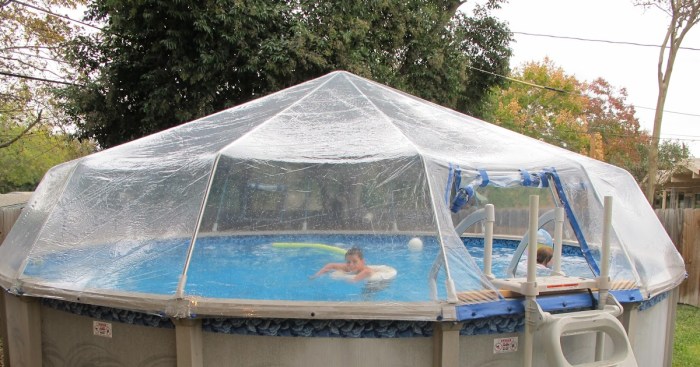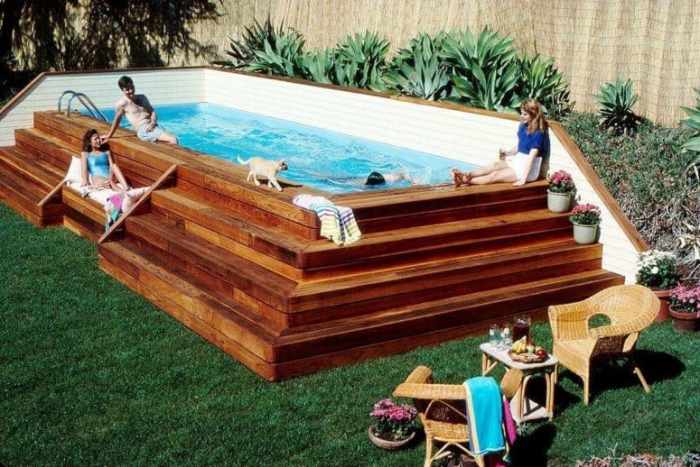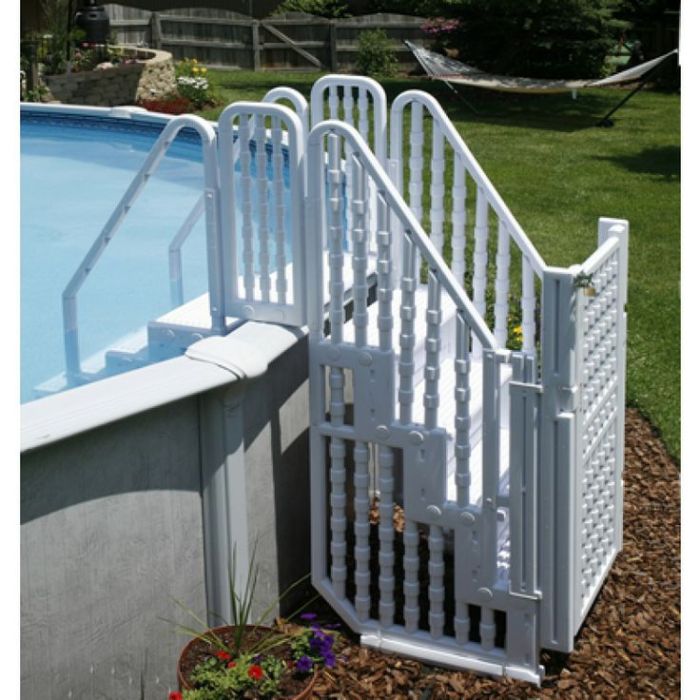DIY homemade above ground pool steps offer a rewarding way to create your own backyard oasis, combining cost savings with the satisfaction of building something yourself. Many homeowners choose to build their own pools for the freedom to customize the design, ensuring it perfectly complements their backyard and lifestyle.
From choosing the right location and size to selecting the appropriate materials, building a pool requires careful planning and execution. This guide will walk you through each step, providing insights and tips to ensure a successful project.
Introduction to DIY Above Ground Pools

Building your own above ground pool is a rewarding project that offers numerous benefits. Not only can you save a significant amount of money compared to hiring a professional, but you also gain a sense of accomplishment and pride in creating something with your own hands.
The decision to embark on a DIY above ground pool project is often driven by a combination of factors. Many people choose this route due to budget constraints, seeking to maximize their investment by taking on the construction themselves. Others are drawn to the challenge and satisfaction of learning new skills and tackling a complex project. The ability to customize the pool design to suit your specific needs and preferences is another compelling reason for choosing a DIY approach.
Reasons for Building a DIY Above Ground Pool
The decision to build your own above ground pool is a personal one, driven by a variety of factors. Here are some common reasons why people choose to take on this project:
- Cost Savings: Building your own pool can significantly reduce the overall cost compared to hiring a contractor. You eliminate the labor costs and potentially save on materials by carefully planning and sourcing supplies.
- Customization: A DIY project allows you to personalize the pool to your specific needs and preferences. You can choose the size, shape, and features that best suit your backyard and lifestyle.
- Sense of Accomplishment: Completing a challenging project like building a pool provides a deep sense of accomplishment and pride. The satisfaction of creating something with your own hands is a rewarding experience.
- Learning New Skills: Building a pool requires a range of skills, from construction and plumbing to electrical work. This is a great opportunity to learn new skills and expand your DIY expertise.
Assembling the Pool Frame

The pool frame is the backbone of your above-ground pool, providing structural support and holding the pool liner in place. Assembling the frame is a crucial step that requires careful attention to detail and proper tools.
Frame Assembly Steps
The process of assembling the pool frame varies depending on the pool’s design and manufacturer. However, the general steps are as follows:
- Prepare the Pool Site: Level the ground and ensure the area is free of debris. This will help ensure that the pool frame sits level and stable.
- Assemble the Bottom Rails: Connect the bottom rails of the pool frame together, ensuring they are securely fastened using the provided hardware. This creates the base of the pool structure.
- Attach the Uprights: Attach the upright sections to the bottom rails, using the provided hardware and tools. The uprights form the vertical support for the pool walls.
- Connect the Top Rails: Connect the top rails to the uprights, ensuring they are securely fastened. This completes the top ring of the pool frame.
- Install the Braces: Install the bracing system, which reinforces the pool frame and adds stability. Braces are typically positioned between the uprights and the top rails.
- Check for Levelness: Use a level to ensure the pool frame is level in all directions. Adjust the frame as needed to achieve a level installation.
Common Challenges and Solutions
While assembling the pool frame is a relatively straightforward process, certain challenges can arise:
- Misaligned Parts: Carefully check the alignment of all parts before securing them. If parts are misaligned, you may need to loosen the fasteners, adjust the parts, and then tighten the fasteners again.
- Difficulty Tightening Fasteners: Use the appropriate tools and apply even pressure when tightening fasteners. If you encounter resistance, double-check the alignment of the parts and ensure you are using the correct size fasteners.
- Uneven Ground: If the ground is uneven, you may need to use shims or adjust the frame to ensure a level installation. Shims are thin pieces of wood or metal that can be used to level the frame.
Tips for Successful Frame Assembly
- Read the Instructions Carefully: Before starting the assembly process, carefully read the manufacturer’s instructions. These instructions will provide detailed guidance on the assembly process, including specific tools and techniques.
- Gather Necessary Tools: Gather all the necessary tools, including a level, wrench, screwdriver, and hammer, before you begin assembling the frame.
- Work with a Partner: It is always helpful to have a partner to assist with lifting and securing the heavier components of the pool frame.
- Take Your Time: Do not rush the assembly process. Carefully assemble each component, ensuring all parts are properly aligned and secured.
Filling and Maintaining Your Pool: Diy Homemade Above Ground Pool Steps

Once your above-ground pool is assembled, it’s time to fill it with water and get ready for swimming! This process involves carefully filling the pool, understanding the importance of water chemistry, and establishing a regular maintenance routine.
Filling the Pool
Filling your pool with water is the first step towards enjoying your backyard oasis. There are two primary methods for filling an above-ground pool: using a garden hose or hiring a water truck.
- Garden Hose: This method is suitable for smaller pools and involves connecting a garden hose to the pool’s fill valve. The filling process can take several hours or even days, depending on the pool’s size and the water pressure. It’s essential to monitor the water level regularly to prevent overfilling.
- Water Truck: For larger pools, a water truck is a more efficient option. These trucks deliver large volumes of water directly to the pool, significantly reducing the filling time. You’ll need to contact a water delivery service and schedule a delivery appointment.
Water Chemistry
Maintaining proper water chemistry is crucial for ensuring a safe and enjoyable swimming experience. It involves balancing the levels of chlorine, pH, alkalinity, and calcium hardness. These chemicals work together to prevent the growth of algae and bacteria, keep the water clear and sparkling, and protect the pool’s equipment.
- Chlorine: Chlorine is the primary sanitizer used in pools. It kills bacteria and algae, preventing them from multiplying and making the water unsafe for swimming. The ideal chlorine level is between 1 and 3 parts per million (ppm).
- pH: pH measures the acidity or alkalinity of the water. The ideal pH range for a pool is between 7.2 and 7.6. A pH level that is too high or too low can irritate swimmers’ skin and eyes, and it can also affect the effectiveness of chlorine.
- Alkalinity: Alkalinity is a measure of the water’s ability to resist pH changes. The ideal alkalinity range for a pool is between 80 and 120 ppm. Maintaining proper alkalinity helps to keep the pH stable, preventing drastic fluctuations that can affect water quality.
- Calcium Hardness: Calcium hardness is a measure of the amount of dissolved calcium in the water. The ideal calcium hardness range for a pool is between 200 and 400 ppm. Too little calcium can cause etching of the pool surface, while too much can lead to scaling and cloudiness.
Pool Maintenance Schedule, Diy homemade above ground pool steps
Regular maintenance is essential for keeping your pool clean, clear, and safe. A typical maintenance schedule includes the following tasks:
| Task | Frequency |
|---|---|
| Skim debris from the water surface | Daily |
| Vacuum the pool floor | Weekly |
| Backwash the filter | As needed (when pressure gauge indicates) |
| Test and adjust water chemistry | Weekly |
| Clean the skimmer basket and pump strainer | Weekly |
| Shock the pool | Once a week or as needed |
Note: The specific frequency of maintenance tasks may vary depending on factors such as pool size, usage, and weather conditions.
Building a DIY above ground pool is a challenging yet fulfilling project. By following the steps Artikeld in this guide, you can create a beautiful and functional pool that will bring years of enjoyment. Remember to prioritize safety throughout the process, and don’t hesitate to seek help from experienced professionals if needed.
Building DIY above ground pool steps can be a rewarding project, but it’s essential to prioritize safety. You’ll want to make sure the steps are sturdy and secure, especially if you’re using them to access the pool from a higher deck. It’s also a good idea to consider the potential impact of the steps on your pool liner, as they can create wear and tear over time.
And just as with any construction project, be sure to consult with a medical professional if you’re taking medications like Eliquis, which can have side effects like bleeding. Eliquis side effects can impact your ability to perform tasks safely, so it’s important to be aware of the risks and take precautions when building your DIY pool steps.
Once your steps are built, be sure to enjoy your new pool access and all the fun that comes with it.
